Have you ever wondered how much money you can get for a 1990 penny? Are you curious if it’s even worth it to collect these coins? Well, these are some of the questions we are going to answer today.
In this post, we’ll do a deep dive into the 1990 penny value, its history, key features, varieties, and possible errors.
1990 Penny Details
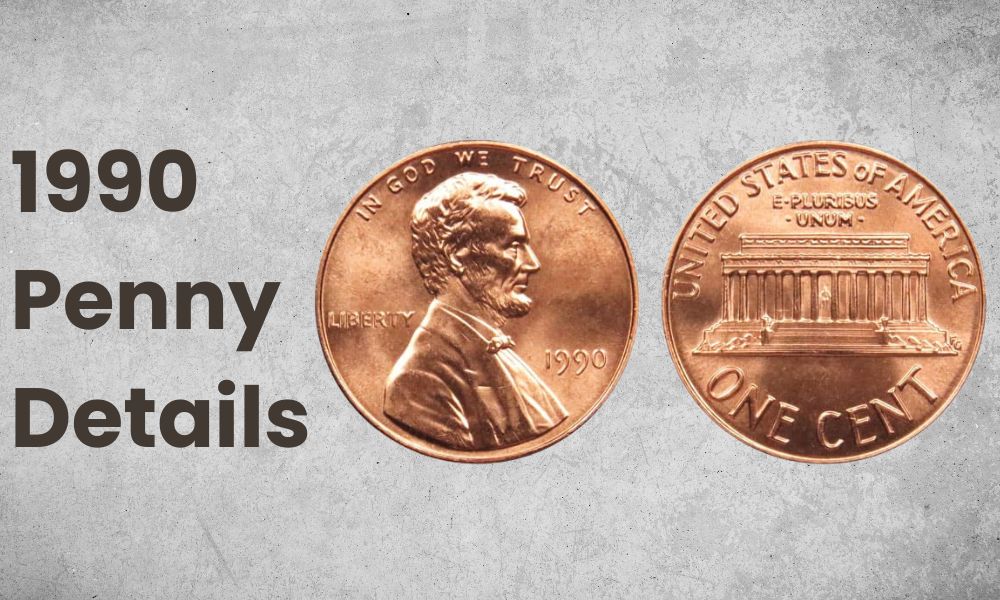
- Category: Lincoln Cents
- Total Mintage: 11,777,959,100
- Minting place: Philadelphia, Denver, San Francisco
- Weight: 2.5 g
- Diameter: 19 mm
- Edge: Plain
- Face value: $0.01 (1 cent)
- Composition: 97.5% zinc and 2.5% copper
- Observe designer: Victor D. Brenner
- Reverse designer: Frank Gasparro
The 1990 Penny’s Obverse Design
The 1990 penny’s obverse bears the image of Abraham Lincoln facing right. To the lower right side of Lincoln, the year 1990 is inscribed. Also, the word “LIBERTY” is written horizontally to the left of Lincoln, behind his neck.
On top of the coin, along its top rim the words “IN GOD WE TRUST” are engraved. Interestingly, the initials of the obverse’s designer, VDB, are written along the cutoff of Lincoln’s shoulder.
This obverse design was originally made by artist Victor D. Brenner in 1909. The only difference between what he created and the 1990 version is the “IN GOD WE TRUST” legend.
The 1990 Penny’s Reverse Design
The 1990 penny’s reverse has the image of the Lincoln Memorial in its center. On top of this building, the words “E PLURIBUS UNUM” are engraved. There is a dot between each word and one at the end.
This Latin motto means “out of many, one”. It refers to the fact that the United States is a nation made of many states. On top of these words, along the top rim of the coin, the words “UNITED STATES OF AMERICA” are engraved.
These words start from the left side of the coin to the right side. Below the memorial, the words “ONE CENT” are written along the bottom rim. These words are in a bigger font than the other words in this design.
This reverse design was made by Frank Gasparro, the mint’s chief engraver from 1965 to 1981.
Other Features of the 1990 Penny
The 1990 penny has a diameter of 19 mm and a weight of 2.5 grams. It is made of copper-plated zinc and has a smooth plain edge.
Also Read: Top 20 Most Valuable Old Pennies Worth Money (Penny Collection)
1990 Penny Value Chart
| 1990 Penny Value Chart | ||||
| Condition | 1990 No Mint Mark Penny (P) | 1990 “D” Penny | 1990 “S” Penny | 1990 “S” No Mint Mark Penny |
| Good | $0.01 | $0.01 | N/A | N/A |
| Fine | $0.01 | $0.01 | N/A | N/A |
| Extremely Fine | $0.1 to $0.25 | $0.1 to $0.25 | N/A | N/A |
| Uncirculated | $0.34 to $7,200 | $6 to $3,000 | $6 to $3,000 | $2,500 to $20,700 |
1990 Penny Value and Varieties Guide
1990 No Mint Mark Penny (P) Value
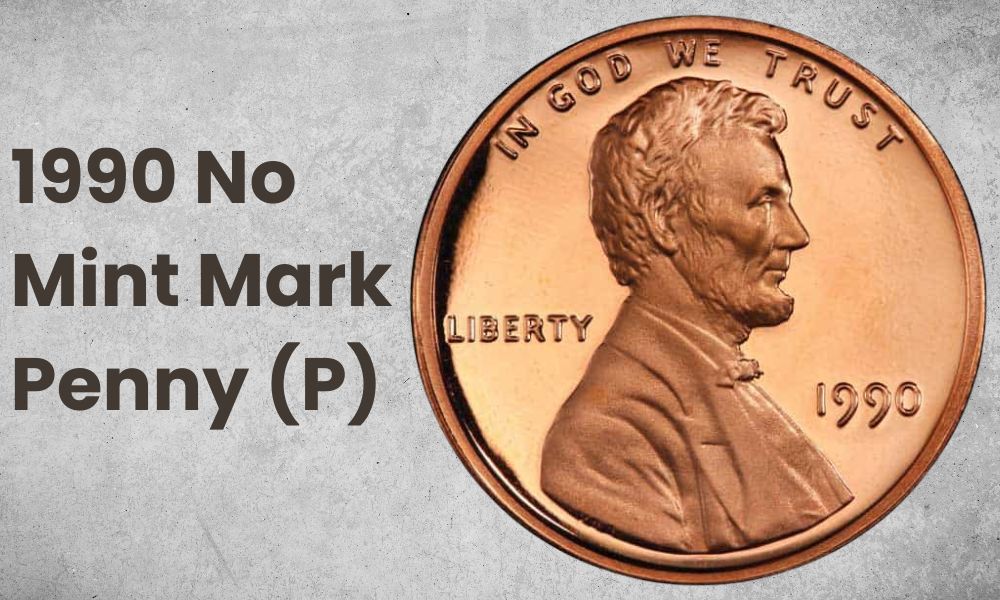
- Type: Lincoln Cents
- Mint Mark: None
- Minting place: Philadelphia
- Year: 1990
- Edge: Plain
- Mintage: 6,851,765,000
- Designer: Victor D. Brenner and Frank Gasparro
- Face value: $0.01
- Current value: $0.01 to $7,200
- %Composition: 97.5% zinc and 2.5% copper
- Mass: 2.5 g
- Diameter: 19 mm
In 1990, the Philadelphia mint produced 6,851,765,000 pennies; none of them had mint marks. This was the highest mintage of 1990 pennies. As such, they are readily available to this day, especially in good and fine grades.
However, they are not that valuable; you can get one for as low as one cent. Even the extremely fine ones will usually go for around 25 cents per piece. The uncirculated ones can go for $5 to $550.
A rare sample, a red PCGS MS69 1990 penny from Philadelphia, even went for $7,200. Remember, the redder and the better the condition of the coin, the more valuable it is.
1990 “D” Penny Value
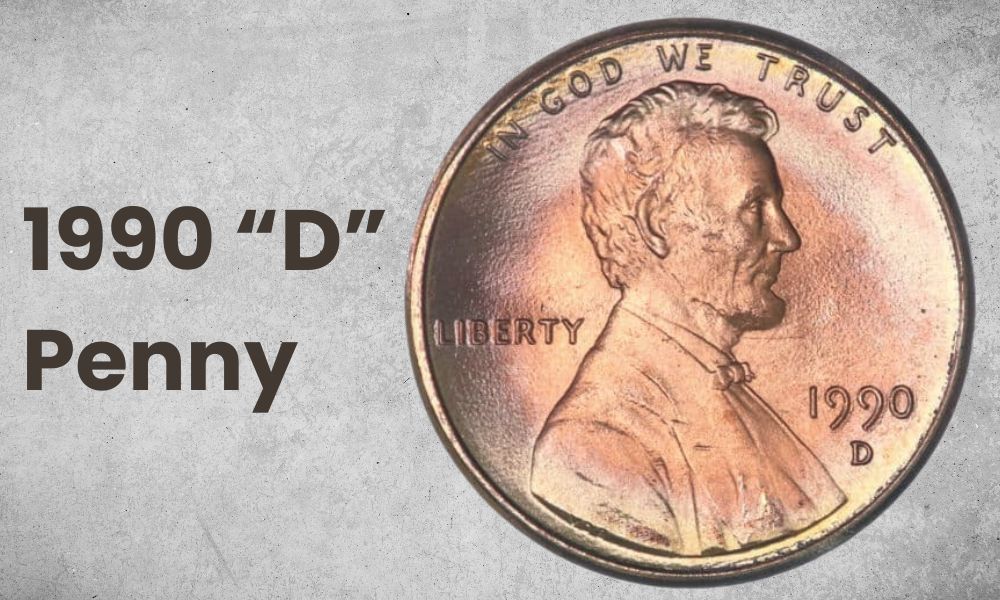
- Type: Lincoln Cents
- Mint Mark: “D”
- Minting place: Denver
- Year: 1990
- Edge: Plain
- Mintage: 4,922,894,533
- Designer: Victor D. Brenner and Frank Gasparro
- Face value: $0.01
- Current value: $0.01 to $3,000
- %Composition: 97.5% zinc and 2.5% copper
- Mass: 2.5 g
- Diameter: 19 mm
In 1990, the Denver mint produced 4,922,894,533 Lincoln cents. Each one had a “D” mint mark. It is located on the coin’s obverse side, just under the 1990 inscription. Due to the high mintage of this coin, it’s still readily available today.
You can buy one for as little as $0.01, especially in low grades. However, a high-grade one can go for thousands of dollars. A red PCGS MS69 1990 D penny even went for $2,937.50 in a 2019 auction.
1990 “S” Penny Value
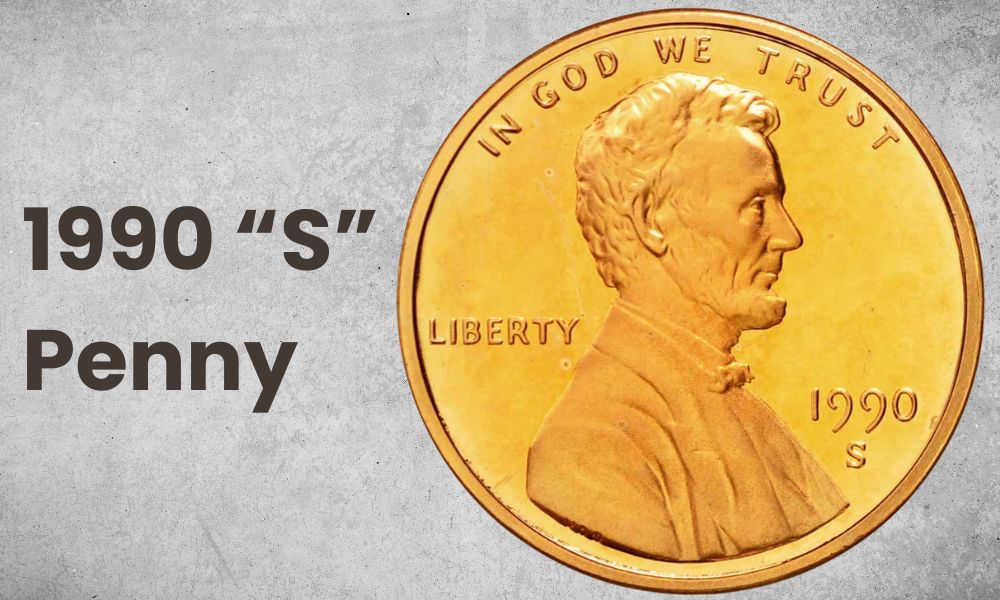
- Type: Lincoln Cents
- Mint Mark: “S”
- Minting place: San Francisco
- Year: 1990
- Edge: Plain
- Mintage: 3,296,504
- Designer: Victor D. Brenner and Frank Gasparro
- Face value: $0.01
- Current value: $6 to $3,000
- %Composition: 97.5% zinc and 2.5% copper
- Mass: 2.5 g
- Diameter: 19 mm
In 1990, the San Francisco mint produced 3,296,504 pennies that had an “S” mint mark. These were all proof coins. As such, collectors kept these coins in pristine condition and you can still find them in this condition today.
Also, since there were so many of these coins minted, they are not particularly expensive, especially when compared to other proofs. You can even get one for a mere $6. However, a few rare ones have sold for over $2,000 in the past.
1990 “S” No Mint Mark Penny Value
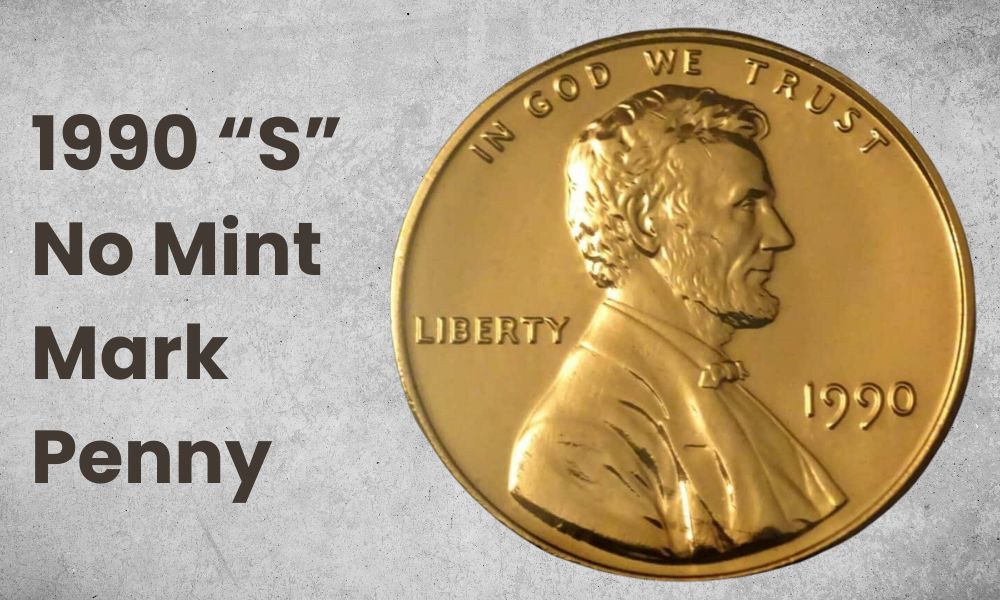
- Type: Lincoln Cents
- Mint Mark: None
- Minting place: San Francisco
- Year: 1990
- Edge: Plain
- Mintage: 3,055
- Designer: Victor D. Brenner and Frank Gasparro
- Face value: $0.01
- Current value: $2,500 to $20,700
- %Composition: 97.5% zinc and 2.5% copper
- Mass: 2.5 g
- Diameter: 19 mm
Apart from the over 3 million proof pennies that had mint marks, the San Francisco mint also produced 3,055 ones that didn’t in 1990. This was an accident. It’s therefore not surprising that these are the only Lincoln pennies to ever lack an “S” mint mark.
The first person to discover their existence was a man called Jim Gullen; he was from New York. When he discovered them, the Mint made an announcement confirming their existence and even confessed to having gotten rid of 145 of these coins already.
These coins remain rare to date; it’s estimated that less than 200 of them still exist. As such, they are usually worth thousands of dollars. A PR69 deep cameo one even sold for a whopping $20,700 in a 2007 auction.
1990 Penny History
The Lincoln cent was first minted in 1909. However, the penny minted in 1909 is not identical to the one minted in 1990 or even today. There have been some changes to this coin’s design and composition over the years.
An artist called Victor D. Brenner made the original obverse and reverse designs of these coins. While the obverse side was edited a little by Charles Barber when the coin was first minted in 1909, most things remained the same until 1958.
The Lincoln cents produced within this time even got the name wheat pennies because they had a unique reverse design bearing two wheat stalks. However, this changed in 1959 when the reverse design started bearing the image of the Lincoln Memorial.
This design only lasted until 2008 though. The 2009 Lincoln cent had 4 different reverse designs depicting Lincoln’s life. One depicted his early life, another his formative years, another his professional life, and the last one his presidency.
In 2010, these reverse designs were replaced with the design used to date; the one with a shield. Interestingly, the obverse design has seen few edits over the years. On the other hand, the composition of these coins has changed severally.
The original Lincoln penny had 95% copper and 5% zinc; this made it weigh 3.11 g. However, this changed in 1943 to a composition of 95% steel and 5%zinc. These coins weighed 2.7 g. But due to staining, these were replaced in 1944 with the previous composition.
Things remained the same until 1982 when the mint started using the composition it uses to date; 97.5% zinc and 2.5% copper.
1990 Penny Grading
Grading a 1990 penny can be done at home or using a professional grading service. Usually, only experienced people can do the former. That’s why it’s important to know which grading company is best for you and when to submit your Lincoln cents to them to grade.
The top professional grading agencies in the United States are PCGS, NGC, and ANACS. The first one usually gives you the best value.
List of 1990 Penny Errors
1. 1990 Penny Double Struck
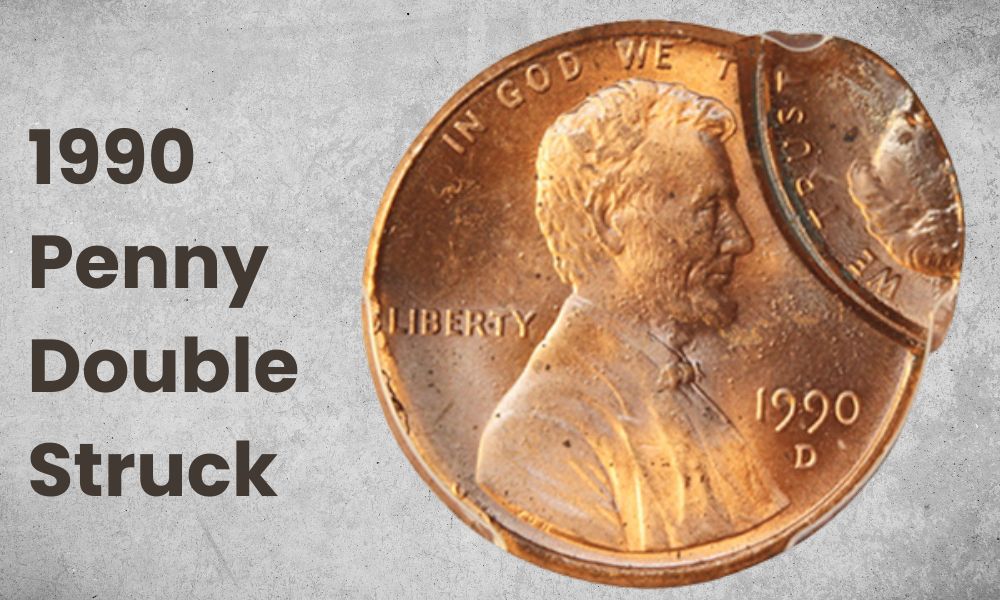
A double strike error occurs when a coin is struck but isn’t ejected from the collar die and eventually ends up being struck again. If the second strike occurs directly on top of the first one, the error is known as a double strike on-center error.
If the second strike is not centered, the error will be known as double strike off-center. Another double strike scenario that can occur is when the coin is struck the first time then flips over and is struck again.
This error is known as the flip-over double strike. It is rarer and more valuable than the other two versions of the double-strike error. However, any kind of double-strike error will add value to your coin.
It can make an otherwise cheap 1990 penny worth hundreds of dollars.
2. 1990 Penny Broad Struck
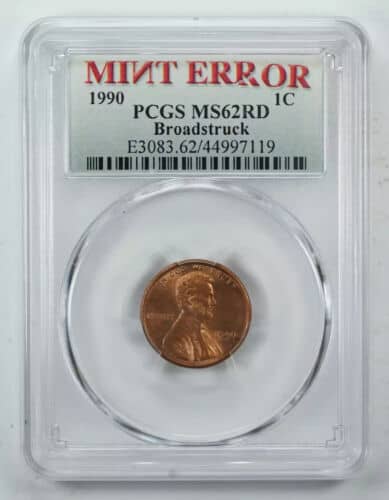
A broad strike error occurs when a coin is struck out of the collar in a centered fashion but the full design is present on both sides of the coin. When the striking is done off-center, the error is known as an uncentered broad strike.
When some of the design is cut out, the error is known as an off-center strike. Whatever the case, this error is valuable, especially when accompanied by other errors.
It’s therefore not surprising that a red PCGS MS64 double-struck and broad-struck 1990 no-mint penny can go for over $150.
3. 1990 Penny Rotation
When you flip over a coin and notice that the image on the other side is a bit slanted, you have a rotation error. This is usually caused by a die that is spinning along its vertical axis. It’s usually difficult to tell which die is causing the problem.
This error can increase the value of your coin, especially when combined with other errors. A red NGC PF67 1990 S double-struck coin with this error can go for over $500.
4. 1990 Penny Struck on Copper Planchet
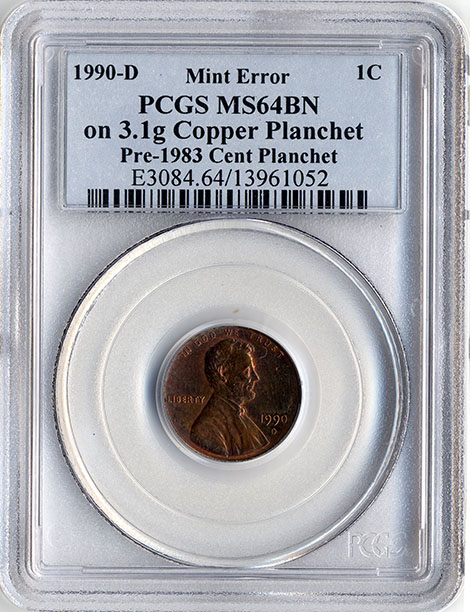
This error occurs when a 1990 penny is struck on a blank with 95% copper and 5% zinc; the composition that was used before 1983. When this happens, the resulting coin weighs 3.11 g instead of 2.5 g.
A brown PCGS MS64 1990 D penny with this error can go for over $5,600.
5. 1990 Penny Double Die
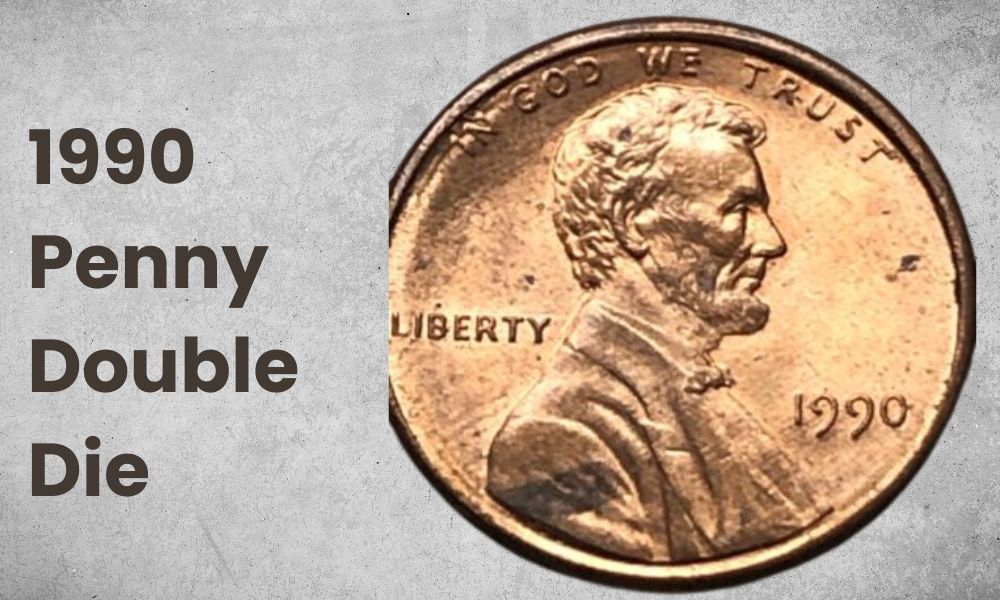
This error occurs when a die has a second impression. So when it strikes a coin, it creates more than one design element. This error can make your 1990 penny go for around $125.
1990 Penny FAQ
What 1990 penny is worth money?
While most 1990 pennies will only get you a few cents, some can earn you hundreds to thousands of dollars. The 1990 S no-mint mark proofs are the most valuable; they can earn you more than $20,000 per piece.
How can I tell if a penny is valuable?
You can do this by checking its date, grade, mint mark, and type. You should also check if it has any errors. Ideally, it’s best if you can estimate the value of a coin before bringing in any professional graders.
This will keep you from wasting your money sending tons of unnecessary coins to them, some of which are cheaper than the grading fees incurred.
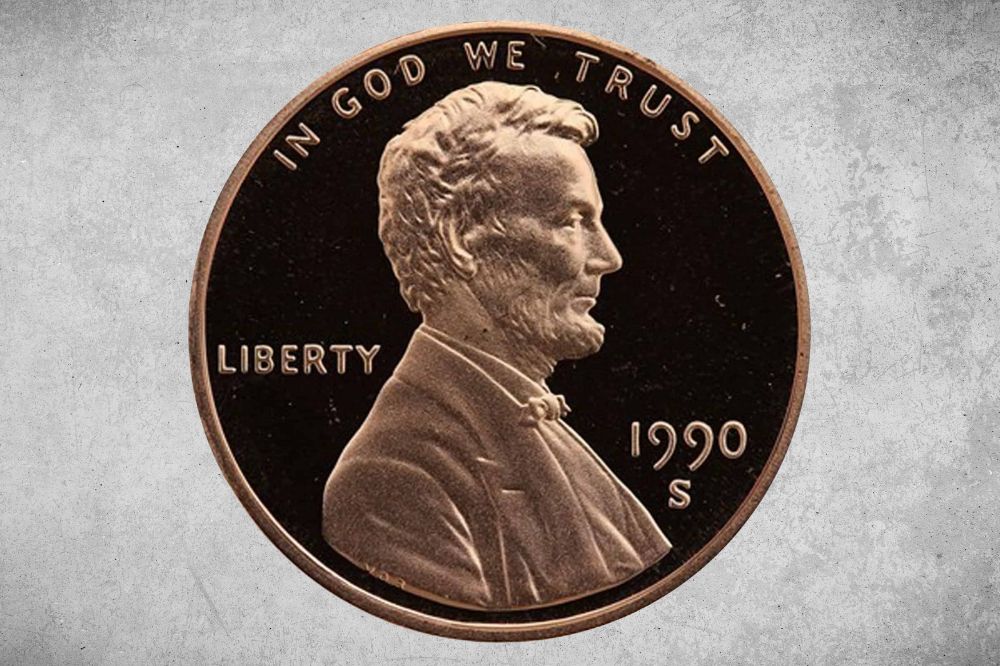
This is very helpful, I enjoyed